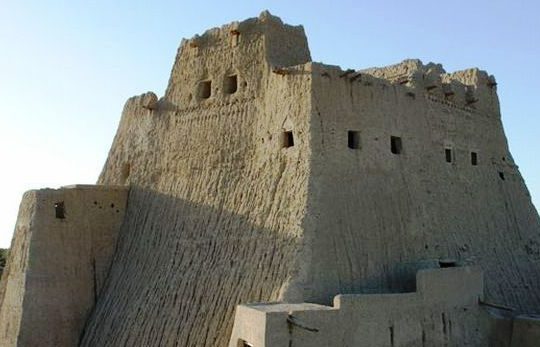Sistan and Baluchestan is one of the most valuable provinces of the country; A province with important works in its heart that has been neglected. Burnt city, Gholaman mouth, Jalalabad citadel and… are only part of the sightseeing places of Sistan and Baluchistan province. In the Sistan sector, less than 50 km away from Zabul, there is a historical castle of Se Kohe, a castle with a long history and local legends. This castle is the second tallest structure in the Sistan plain and has been registered in the list of national monuments of Iran.
The historical castle of Se Kohe is one of the sights of Zabul, and it is the second tallest building in the vast plain of Sistan after Khwaja Mountain. This castle is built on a rectangular and elevated land with an area of about 3,700 square meters and has two entrances from the east and west. The western entrance of the castle is impassable and has suffered many damages. The eastern entrance also has a steep slope.
Se Kohe Castle is located in Shibab section, in Se Kohe village, in Zabul city. This historical castle leads from the northeast to semi-circular plains, from the south to the village of Del Asa, from the west to the lands of Lotak village, and from the northwest to Sam Castle.
Three mountains have been created from the retreat of the water of the Zabel Plain and are located on the Zabel route towards Zahedan and on the slope of the route.
Due to its location on the path of the Hirmand River, the Three Mountains were completely submerged, and later, by changing the direction of the river, it came out of the water and appeared as three ridges or three mountains on the dry land of the Sistan plain. In this way, three mountains came out of the water in the form of three islands, and then, gradually, with the receding of the water of the river plain, its entire area has come out of the water.
Many are of the opinion that the architectural features of this region go back to the Afshariya period. The peak of the political and military life of Se Kohe Castle is related to the time of Naser al-Din Shah Qajar; in such a way that during the colonial efforts of the British government and the isolation of parts of Iran, it played an important deterrent role and played an effective role in the campaign to Herat. Sardar Ali Khan Sarbandi was the first person to submit to the central government of Iran and raised the Iranian flag in 1231 AH over the Se kohe Castle.
This historic castle, whose history dates back to the Qajar era, is the last residential fortress where the ruler of that region was settled.
Se Kohe Castle is a symbol of Sistan architecture and it is among the last buildings that were built in this style.
Se Kohe Castle is one of the places in Sistan where the Iranian flag was raised during the struggle between Iran and Britain. This fort for many years witnessed the peak of military and political conflicts between Britain and Iran during the reign of Naser al-Din Shah Qajar and has caused the recapture of parts of the country during the war.
Next to the three-mountain castle of Zabul, there is a small citadel on the third mountain, the area of which is 2000 meters. This small citadel is only 20 meters away from the three-mountain castle of Zabul, and this small distance has caused many historians to hypothesize that the citadel and the castle are one and the same. The traces of life in this citadel are clearly visible.
According to the statements, coins were minted in this castle; Also, there was a well on the southern side of the castle, into which the bodies were thrown during the war. This well was very deep; So that when the people threw a stone in it, its sound was not heard. Today, only a hole remains from this point. Anyway, this fort is a part of the history of Sistan, where many political and social issues have occurred, and a part of the history of recent centuries of Sistan is related to it.
The architecture of Se kohe Castle is in the style of Sistan architecture. There are two types of song arches in this castle. This type of arch is along a line and cannot be used on uneven surfaces with protrusions, and it is better to make sure that the bottom surface of the arch is flat and rectangular. These arches can be used in two ways, Russian and full, with the help of one and two pillars. In the corridors of the castle, arches with a low rise are used, and in the design of the rooms, arches with a higher rise are used.
The construction of existing houses in Se Kohe village, like other settlements in Iran, first included the Chinese wall, then specifying the porches and doors, and finally roofing the ten houses. The method of making a roof for the houses of Sistan region is in this way that on one side they start building the roof to a part less than half of it and on the other hand they go the same amount to build the roof. When the ceiling studs meet the walls of the room, they start laying a few more rows on each side to finish the ceiling. The roofs of the houses in the Sistan plain are usually made in the dome shape and in the Yazdi style.
Northern citadel: This part of the castle was the resting place of the ruler and his companions. The northern citadel has a polygonal exterior with a domed surface and high arches, and it has a much smaller area than the southern citadel of the castle. The northern citadel is also called Malek Sar or Falak Sar.
Field Citadel: This part of the castle is full of small and large rooms that were a place for resting and sleeping for servants and soldiers protecting the ruler and his companions. This part is between the northern and southern citadels.
South citadel: This part of the castle belongs only to the ruler of the time and like a replica palace, it included a long and narrow porch, a small courtyard and a number of rooms in the northern part of the courtyard.




